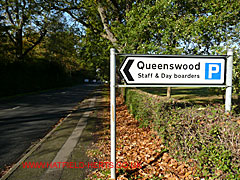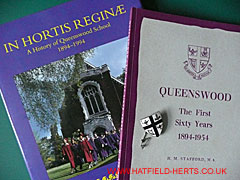 Queenswood
– Part 2
Queenswood
– Part 2
In this part we look at a few of the notable people in Queenswood's history. Some were members of staff, members of the Board of Governors and others were honoured guests. Plus, a bit about some of the buildings that make up the fabric of Queenswood.
Some notable people in Queenswood's history
Reverend Doctor David J Waller – Founder and chairman 1894-1911. Served as Secretary of the Wesleyan Education Committee and President of the Wesleyan Conference. He died, aged 75, in 1911.
Marion Waller – Headmistress 1894-97. Second daughter of Rev Waller, and previously Head at West Cornwall College, Penzance. She left Queenswood after marrying Reverend J Alexander Stewart McCaskill but sadly died in childbirth a year later in Scotland.
Ethel Mary Trew – Headmistress 1897-1943. An associate of Marion Waller at West Cornwall College she joined her at Queenswood. Even though she retired as headmistress in 1943 she remained principal for another year, and managed the estate until her death on 7 December 1948.
Lord Josiah Charles Stamp – Joined the Board of Governors in 1924, and took over the chairmanship from Rev Hartley in 1927. Born in 1880, he joined the Inland Revenue as a clerk in 1896. From humble beginnings he rose to become one of the outstanding men in an era of outstanding individuals. He was awarded some 23 honorary degrees (although he gained a First Class degree in economics from LSE – without tution – in 1911). Served as a director and company secretary of Nobel Industries (later amalgamated to form ICI); chairman of the London Midland & Scottish railway company; and appointed as a governor of the Bank of England. Created as the first Baron Stamp of Shortlands in 1938, he worked as an economic adviser to the Government from July 1939 (although he reportedly turn down Neville Chamberlain's offer of Chancellor of the Exchequer in 1940). He was killed, along with his wife and eldest son, in an air raid in 1941.
Enid M Essame – Headmistress 1944-71 (although one source says 'since 1943' – probably due to Miss Trew's protracted departure). Joined the staff of Queenswood in 1923. Assistant Headmistress from 1935.
Reverend Doctor Marshall Hartley – Founder and chairman 1911-1927. Born in 1846, he entered the ministry in 1868. In 1888 he was appointed one of the general secretaries of the Wesleyan Foreign Missionary Society (a position which he held for 37 years). He visited Methodist missions around the world, including India, China, Ceylon (Sri Lanka) and South Africa. He died in December 1928, at the age of 82, and was cremated.
Sir Harold Bellman – Governor, Vice Chairman and appointed Chairman in 1941, following the death of Lord Stamp. Charles Harold Bellman was a distinguished public figure – an author, Governor of the London School of Economics and a leading figure in the Building Society movement in Britain and internationally (he is closely associated with the Abbey Road Building Society, which became Abbey National). He died, aged 77, in 1963.
Dr Eric Strickland Waterhouse – Governor 1932-64. Emeritus Professor of the Philosophy of Religion at the University of London. An outstanding Methodist scholar, he was the author of numerous books. He died, aged 84, in 1964.
Ernest Read – Professor of Music at the Royal Academy of Music, renown for his Children's Concerts. He founded the London Junior Orchestra in 1926 (which led to the creation of the Ernest Read Symphony Orchestra in 1931). He was Musical Director of Queenswood. He laid the foundation of the Arts Block in May 1965. He died in October that year, aged 86.
Dorothea Lambert-Chambers – 7-times Wimbledon champion and Queenswood tennis coach 1936-40. Born in 1878, as Dorothea Katherine Douglass (her maiden name), she won her first Wimbledon title in 1903. Although she died in January 1960, she remains Britain's greatest women's tennis champion. She was inducted into the International Tennis Hall of Fame in 1981.
Headmistresses
Marion Waller 1894 - 1897
Ethel Mary Trew 1897 - 1943
Enid Essame 1943 / 4 - 1971
Margaret Ritchie 1971 - 1981
Audrey Butler 1981 - 1996
Clarissa Farr 1996 - 2006
Pauline Edgar 2006 -
Please note: dates indicates their tenure as headmistress and not necessarily when they joined or left the school.
Buildings
Apart from the original Sheepwell House, (named Head's House when it was destroyed by fire and rebuilt – as mentioned in Part 1), a number of other buildings were erected to make the Queenswood of today. These are just some of them.
Main School – Built in 1925. With extensions 1927-29.
Chapel – Opened in 1928 at a cost of £14,000. The architect was Alderman Josiah Gunton, a Fellow of the Royal Institute of British Architects (FRIBA).
Sanatorium (now Belling Centre, which opened in 1985) – Built in 1926.
Swimming Pool – Opened in 1933 by the Marquess of Salisbury (although one book suggests it was built in 1930).
Senior House (now Trew House) – Built in 1930.
Gymnasium – Built in 1933.
Stamp House – Built in 1935.
Science Block and Bellman Library – designed by C Lovett, Gill and Partners in 1956. Fundraising dinner held at Grosvenor House on 23 October that year. Science Block opened in 1957. Library foundation stone laid by Sir Frank Taylor (founder of Taylor Woodrow) in 1957.
Audrey Butler Centre (ABC) – opened by Joanna Foster (Chair of the Equal Opportunities Commission) in 1991. Named after Audrey Butler (nee Minchin), first former student to become Headmistress of Queenswood (its 5th) in 1981.
Leach Centre – opened in 1992 and named in memory of Robin and Heather Leach (a former student) killed in a helicopter crash earlier that year.
 Books
Books
The Queenswood has been the subject of two books. The first was written by Miss H M Stafford (a senior member of staff) and was called Queenswood: The First Sixty Years 1894-1954. Published in 1954, this 64-page illustrated history is perhaps more of a souvenir programme than a book. The second is a much more detailed and comprehensive work. In Hortis Reginae: A History of Queenswood School 1894-1994, was written by Nigel Watson, and published in the school's centenary year.
Some of the VIP guest speakers and visitors
Queenswood has seen some very distinguished people turn up for special school occasions. These are just a few of them.
Sir William Bragg – came from a family with no academic background and his mother died before he reached the age of 7. Granted a scholarship by Trinity College, Cambridge he went on to become Professor of Mathematics and Physics at the University of Adelaide. Elected to the Royal Society in 1907 (proposed by Ernest Rutherford), and offered a professorship at Leeds. After his return to England, he designed the Bragg Ionization Spectrometer in 1912. In 1915 he and his son, Sir Lawrence Bragg, were jointly awarded the Nobel Prize for Physics. During WWI he worked on anti-submarine devices. Guest at Queenswood's 1929 prize giving. President of the Royal Society from 1935-40.
Sir Cyril Norwood – after graduating from St John's College, Oxford, he worked for the Civil Service and the Admiralty before he decided that education was his calling. Five years after joining the staff at Leeds Grammar School he was offered his first post as headmaster. In this capacity he served at three of Britain's leading schools in succession: Bristol Grammar School, Marlborough and Harrow. Sir Cyril distributed the prizes at the 1934 Commemoration Day. The next month (July) he left Harrow to become President of his former college in Oxford. A post he held until his wife's ill-health forced him to resign in 1946. He died in 1956 at the age of 80.
Lord Tweedsmuir – best known as the author, John Buchan, whose Hannay character was a forerunner to James Bond. He was also a lawyer, publisher, historian, biographer, soldier and politician. He was a guest speaker at the 1935 Speech Day – the year he was appointed as Governor-General of Canada. He died in Montreal in 1940.
Queen Mary – visited in March 1938, and became the first queen to walk in the gardens of Queenswood. Born a German Princess, Mary of Tec, she married King George V and was mother to two British kings – King Edward VIII and King George VI. She died shortly after her grand-daughter was crowned as Queen Elizabeth II in 1953.
Queen Elizabeth, The Queen Mother – visited in 1955. Following in her mother-in-law's footsteps, she became the second queen to walk in the gardens of Queenswood. Born in 1900, her father inherited a Scottish earldom. She married the future King George VI and holds a special place in history as Britain's Queen during WWII. She also was a frequent visitor to Hatfield (during the war she visited injured servicemen at Hatfield House when it was in use as a hospital), and together with both her daughters, made her first flight in a jet aircraft (DH.106 Comet) from Hatfield airfield. She had the sad task of attending the funeral of both her husband and their youngest child, Princess Margaret, before her own passing in 2002.
General Sir Bernard Charles Tolver Paget – first commissioned in 1907, he served with distinction in WWI, having been wounded twice, mentioned in dispatches four times and decorated with the DSO and MC. He served on General Sir Douglas Haig's staff at General Headquarters. In WWII he took command of British forces facing dire peril in the disastrous Norway Campaign in 1940, and managed to extricate them with such skill that he was praised by the Prime Minister in parliament. He later served as Commander in Chief, Home Forces and C-in-C, Middle East. In 1950 he was a guest speaker at Queenswood. He died, aged 73, in 1961.
Madame Vijaya Lakshmi Pandit – Indian High Commissioner to Britain (1954-61) and sister of India's first Prime Minister Pandit Nehru. She had previously served as India's first ambassador to the Soviet Union (1947-49), and India's ambassador to the USA (1949-52). She also led India's delegation at the United Nations for many years, and was appointed President of the General Assembly in 1953-54. She was a guest speaker at the 1956 Commemoration Day. She later served as Governor of the Indian state of Maharashtra and an MP till she retired in 1970.
Miss Clemence Dane – born Winifred Ashton, she is better known by her pen name Clemence Dane – which was inspired by St Clement Dane's Church in The Strand (the RAF's Church). However, she used the pseudonym Diana Portis for her acting debut in 1913. She briefly worked as a teacher in a girls' school. But after WWI she soon found success as an author and playwright. She also wrote scripts for musicals and films, and her work was used by the likes of Douglas Fairbanks Jr, Ivor Novello, Vivien Leigh and Katherine Hepburn. Another of the guest speakers at Queenswood during Miss Essame's tenure as headmistress, she died in March 1965.
Lord Tom Denning – considered to be the most celebrated English judge of the 20th Century (but not entirely without controversy). Born the son of a draper in 1899, he served as Master of the Rolls for 20-years (out of the 38-years he spent as a judge). During which time he headed the inquiry into the Profumo Affair. Lord Denning was a guest speaker at the 1966 Commemoration Day. He died, aged 100, in March 1999.
Back to: Features on Hatfield8 December 2009